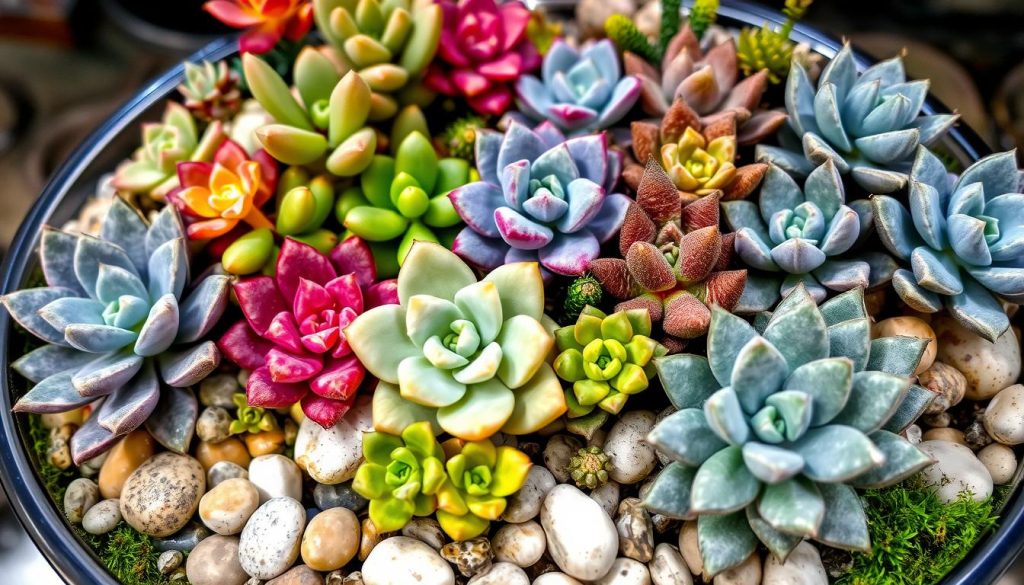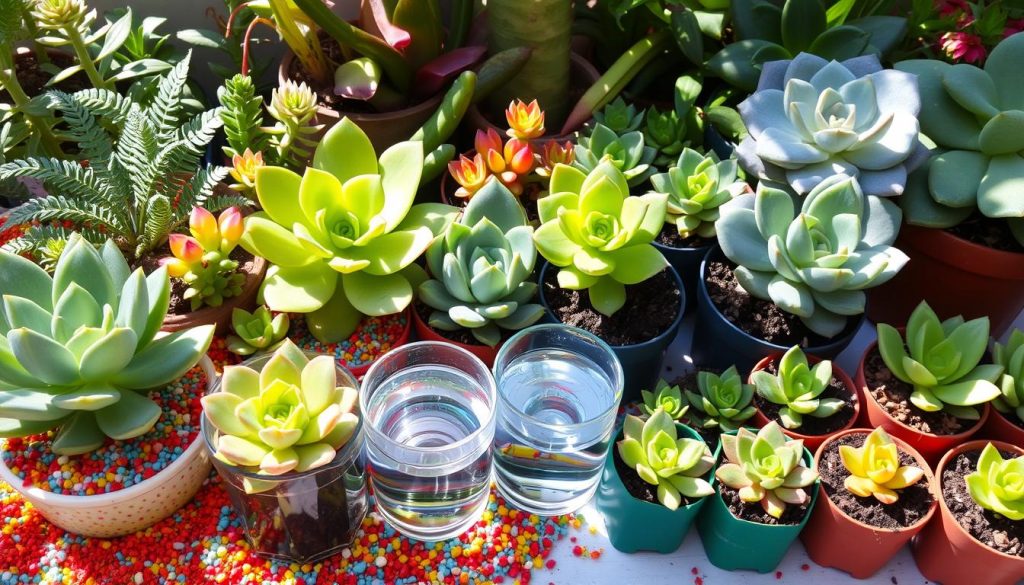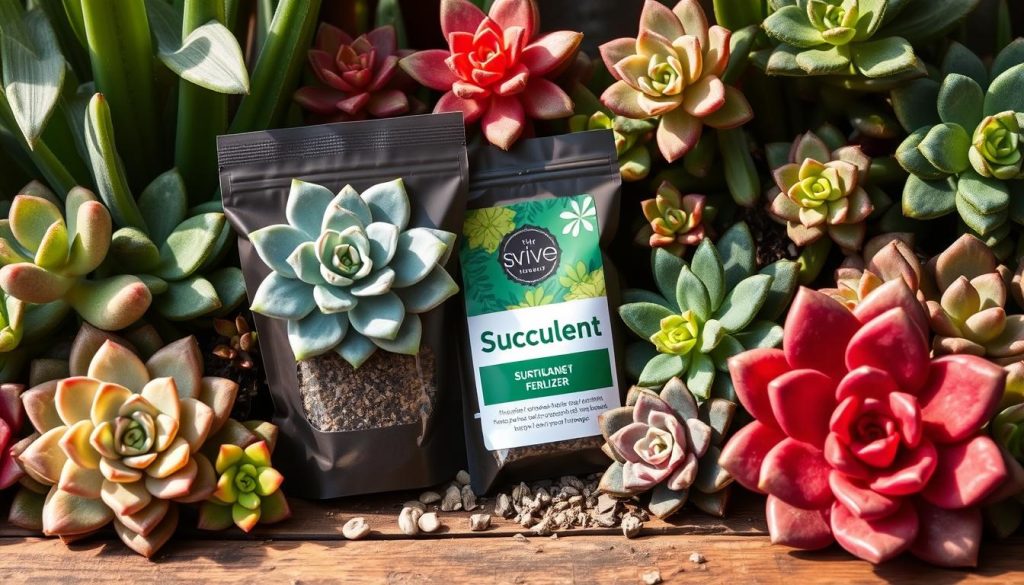Succulents are loved by many for their unique leaves and stems. They store water, making them great for dry places. With over 20,000 types, they come in many colors and sizes for any space.

Key Takeaways
- Succulents are popular for their unique and fascinating foliage rather than their flowers.
- Succulents are native to dry, arid regions and can withstand long periods without water, making them ideal for drought-prone areas.
- Proper soil, drainage, and lighting are essential for healthy succulent growth, with most preferring well-drained soil and full sun to partial shade.
- Overwatering is a common issue with succulents, which can lead to root rot, so it’s important to water them sparingly and adjust the schedule based on the season.
- Succulents can be propagated through various methods, including leaf cuttings and offsets, allowing gardeners to create their own mini-succulent gardens.
Understanding Succulents: Nature’s Water Storage Experts
Succulents are amazing plants that can live in dry places. They store water in their thick leaves and stems. This makes them great for desert gardens or water-saving landscaping.
What Makes a Plant a Succulent?
Succulents can hold a lot of water in their leaves and stems. This is different from other plants. It helps them survive in places where water is hard to find.
The Difference Between Cacti and Succulents
All cacti are succulents, but not all succulents are cacti. Cacti have spines instead of leaves to store more water. This helps them live in very dry places.
Natural Habitats and Adaptations
Succulents live in many places, from deserts to tropical areas. They can store water, which lets them thrive in different environments. Each type of succulent has its own special way of adapting to its home.
For example, plants like Aloe vera and Echeveria have thick leaves full of water. Some plants, like certain Euphorbia species, store water in their stems instead of leaves. This means they might not have leaves at all.
Some plants, like Lithops, have a special part called a caudex. This part stores water and nutrients. It helps them get through long dry spells.
The world of succulents is full of amazing adaptations. Plants use different ways to store water, like in leaves, stems, or caudexes. By understanding these, gardeners can take better care of these incredible plants.
Popular Succulent Varieties for Beginners
If you’re new to houseplants, succulents are a great start. They’re easy to care for and live a long time. This makes them perfect for people who are busy or new to plant care.
The Jade Plant (Crassula ovata) is well-known. It grows slowly and can get up to 6 feet tall. The Aloe Vera is also popular. It’s good for you and can grow well indoors.
Echeveria plants are loved for their beautiful rosette leaves. They come in many colors and sizes. Sedum, or Stonecrop, is another favorite. It includes plants like the Burro’s Tail and the Panda Plant.
The Snake Plant (Sansevieria trifasciata) and the Zebra Plant (Haworthia Zebra) are great for indoor gardens. They have cool patterns and are tough against pests and diseases.
For outdoor gardens, try Hens-and-Chicks (Sempervivum) and Sedum species. They can handle different climates, from hot deserts to cooler areas.
There are over 10,000 types of succulents. This means beginners have endless options. Whether for indoor greenery or outdoor displays, these plants are sure to impress.
Essential Growing Conditions for Healthy Succulents
Keeping the right growing conditions is key for your indoor plants and outdoor succulents. They need the right light, temperature, and humidity. Knowing their needs helps your succulents grow well.
Light Requirements
Succulents love bright, direct sunlight. Most need 6-8 hours of sunlight daily. Some need up to 10 hours for the best growth. If indoors, use artificial light to make sure they get enough.
Temperature Preferences
Succulents like cooler nights and warmer days, between 55°F and 75°F. Some can handle temperatures as low as 45°F. But, protect tender ones from frost and cold, especially outdoors.
Humidity Considerations
Succulents do well in dry air, with humidity as low as 40%. Too much humidity can cause mold and fungus. So, keep their environment dry to avoid these problems.
Soil Requirements and Potting Basics
Succulents love well-draining soil. To make the perfect mix, mix one part organic stuff like compost or peat moss with one part sand or gritty stuff like perlite or pumice. This mix helps your succulents grow well by giving them the right soil and air.
For growing succulents in pots, pick terra cotta pots that breathe and have lots of holes for water to drain. This stops the roots from getting too wet and rotting. If you’re making an outdoor garden, add sand and gravel to the soil to help it drain better.
- Most succulents do well in sandy, draining soil with little organic matter and nitrogen
- A mix of two parts sand, two parts potting mix, and one part perlite or pumice is a good start
- Stay away from heavy garden soil or water-holding mixes, as succulents need great drainage
- Porous terra cotta pots with holes are best for growing succulents in pots
- Adding sand and gravel to native soil helps with drainage when planting outdoors
By giving your succulents the right soil and potting setup, they’ll thrive. You’ll get to enjoy their bright, healthy growth for many years.
Proper Watering Techniques and Schedule
Watering succulents is a delicate task that needs careful attention. To keep them healthy, water them well but not too often. Let the soil dry out completely between waterings. During the growing season, water your succulents once a week. But, in winter, water them less to avoid root rot.
Signs of Under and Overwatering
Watch for signs your succulents give to avoid watering mistakes. Underwatered plants have wrinkled or shriveled leaves. Overwatered ones turn yellow, get mushy, and may grow fungi. Check the soil and look at your plants to keep them healthy.
Seasonal Watering Adjustments
- Small potted succulents like Peperomia need water every 2-3 weeks in spring and summer.
- Bigger succulents, like Aeonium, might only need watering once a month in the growing season.
- In fall and winter, succulents can go 2-4 months without water.
- Indoor succulents need water every 2-4 weeks, less in winter.
- Outdoor succulents get water every 1-2 weeks in the growing season. Adjust based on your local weather.
Knowing your succulents’ watering needs helps them thrive. Adjust your watering schedule to keep them healthy and water-efficient.
Indoor Succulent Care Tips
Adding houseplants to your home is easy. Succulents, known for being easy to care for, do well indoors. They need just a few things to grow well. These tips will help your indoor succulents thrive.
For the best light, put your succulents in a sunny spot. They need at least 6 hours of direct sunlight a day. If that’s not possible, find the brightest spot in your home or office.
Watering is crucial for your succulents. Let the soil dry out completely before watering again. This can be every 1-4 weeks, depending on how humid it is and how much light they get. They need less water when it’s cooler.
- Use well-draining soil and pots with holes to prevent waterlogging, which can cause root rot.
- Opt for terra-cotta containers, as they allow for better air circulation around the roots.
- Monitor for common pests like mealybugs and scale insects, and treat with rubbing alcohol if needed.
With the right light, watering, and soil, your indoor succulents will do great. They’ll add beauty to your space without much work. Enjoy watching them grow.
Outdoor Succulent Gardening
Adding succulents to your outdoor space can make your yard look amazing and save water. You can have a whole succulent garden or mix them with other plants. There are smart ways to do this.
Creating a Succulent Garden
Group succulents by their care needs in your outdoor garden. This makes it look better and easier to care for. Use rockeries or raised beds for better drainage, as succulents love well-draining soil.
Plant them in clusters for a natural look. This avoids the look of rows or single plants.
Landscaping with Succulents
Succulents are great for more than just gardens. They fit well into your outdoor design. Choose hardy types like Yucca, Opuntia, and some Agave for easy care and beauty.
These plants handle different climates well. They’re perfect for many places, from mild to cold.
Succulents add beauty and save water in your outdoor areas. You can have a special succulent garden or mix them with other plants. Either way, you’ll get a beautiful, water-saving space that’s easy to care for.
Container Growing and Design Ideas
Succulents are great for container gardening because they’re easy to care for and come in many shapes. They love dry conditions, making them perfect for small areas like patios or balconies. To make a beautiful succulent arrangement, mix different colors, textures, and growth habits.
First, pick a shallow container with holes for drainage. Use soil that drains well to prevent rot. For hanging baskets, try plants like String of Pearls. For a centerpiece, use plants like Echeveria or Aeonium.
- Sedum ‘Matrona’
- Echeveria ‘Perle von Nurnberg’
- Senecio rowleyanus (String of Pearls)
- Sedum morganianum (Burro’s Tail)
- Aeonium ‘Kiwi’
Think about how big each succulent will get when arranging them. Too many plants can stunt their growth. Try out different colors and textures to make a succulent arrangement that’s all your own.
Whether you’re new to gardening or have lots of experience, container gardening with succulents is fun and easy. These plants are diverse and can turn any space into a lively, water-saving oasis.
Succulent Propagation Methods
Propagating succulents is rewarding and easy. It’s great for growing your plant collection. You can expand your indoor garden or create stunning outdoor displays. Let’s look at three common methods: leaf cuttings, stem cuttings, and division/offsets.
Leaf Propagation
Leaf propagation works well for succulents with flat leaves, like Echeveria and Jade plants. Just snip off a healthy leaf and let it dry for a few days. Then, plant it in succulent soil.
With care and patience, roots and new rosettes will form. This method is popular among succulent lovers because it’s successful.
Stem Cuttings
For succulents with long stems, like Aeonium and Sedum, use stem cuttings. Cut a 3-4 inch piece from a healthy stem. Let it dry for 4-7 days, then plant it in well-draining soil.
The cutting will root and grow new stems. This is great for plants that grow long stems.
Division and Offsets
Many succulents, like Sempervivum and Agave, produce offsets or “pups.” These small plants can be separated and replanted. This method is easy and efficient for dense plants.
Wait for the offsets to grow their own roots before transplanting. This way, you can grow more plants from your existing ones.
Choose the right method for your succulents. Use a well-draining potting mix and plenty of light. With patience and care, you can grow your succulent collection through propagation and succulent reproduction.

Seasonal Care and Maintenance
Caring for succulents means changing your routine with the seasons. In spring and summer, when they grow fast, water and fertilize more. This helps them grow strong. In fall and winter, water less because they’re dormant and don’t need as much.
If your succulents can’t handle frost, move them inside or protect them well. Prune them in early spring to keep them looking good and growing well.
- Increase watering and fertilizing during the active growth phase in spring and summer.
- Reduce watering in fall and winter as succulents enter dormancy.
- Protect non-hardy succulents from frost by moving them indoors or providing cover.
- Prune and shape succulents in early spring before the growing season starts.
By changing your care routine with the seasons, your succulents will stay healthy and look great all year.
Pest Management and Disease Control
Succulent lovers need to watch out for pests and diseases. These plants can get sick from bugs or fungi. Knowing the signs and acting fast can help your succulents stay healthy.
Mealybugs, scale insects, and spider mites are common pests. Mealybugs look like cotton and suck the plant’s energy. Scale insects can quickly cover a succulent. Spider mites love hot, dry places and make leaves turn yellow.
To fight these pests, use neem oil or horticultural oils. These oils can kill the bugs by suffocating them.
- Mealybugs are one of the most common pest problems for succulents.
- Scale insects can cover the entire surface of a succulent in a couple of days.
- Red spider mites reproduce more rapidly in hot weather.
Fungal diseases like root rot can also harm succulents. They often come from too much water or bad drainage. Signs include wilting, colored leaves, and a bad smell.
If you catch it early, treat the area with fungicide. Also, make sure the plant has good drainage to stop it from coming back.
Checking your succulents often is important. Look for yellow leaves, slow growth, or pests. With careful watching and the right treatments, your succulents will stay beautiful for a long time.
Fertilizing Guidelines and Requirements
Caring for succulent plants needs a careful touch when it comes to fertilizing. These plants do well with a little bit of food. So, it’s key to fertilize them lightly and wisely.
Types of Fertilizers
Choose a balanced, water-soluble fertilizer that’s half strength. Or, pick a special succulent food. It usually has more phosphorus to help roots grow strong and colors pop.
Application Timeline
- Fertilize your succulents when they’re growing most, like in spring and summer.
- Put the diluted fertilizer out every 2-4 weeks then.
- Don’t fertilize in fall and winter. They need less during this time.
Getting the right amount of fertilizer is crucial. Too much can cause root rot. Too little can stunt growth and change color. Stick to these tips to give your succulents the best food for growth.

Decorative Uses and Arrangements
Succulents are now a top pick for home decor and landscaping. They look unique and are easy to care for. These plants can turn any space into a living art piece, a colorful terrarium, or a stunning centerpiece.
Succulents are great for succulent decor in many ways. They can be used in vertical gardens, green roofs, wedding bouquets, and more. Their varied shapes, textures, and colors open up endless design options. This makes them a hit with DIY fans and professional designers.
When making a succulent centerpiece or decorating a space, know what each plant needs. Arrange them to highlight their beauty. With some creativity and care, you can make your home a lush, low-maintenance succulent decor oasis.